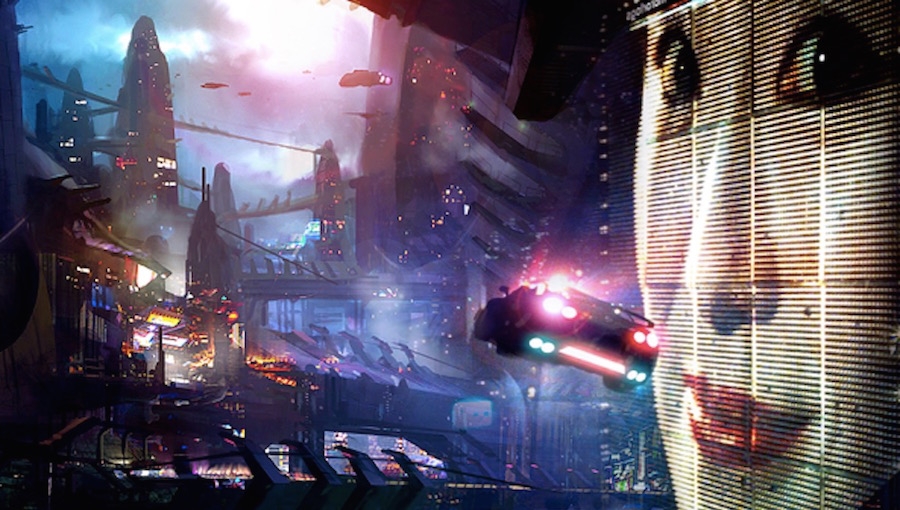In 1982, Ridley Scott directed Blade Runner, his vision of a futuristic, dystopian, neo-noir science fiction film which was loosely adapted from the Philip K. Dick novel, Do Androids Dream of Electric Sheep? Neon store-front lights reflect in the rain slicked Los Angeles of 2019 as brightly lit dirigibles rumbled across the dark sky, flashing elaborate advertisements overhead. All manners of life – human and replicant – commingle, trying to find meaning and memorable moments that culminate into a comforting identity. Drawing on themes of religion, technology, implications of genetic engineering, and an examination of humanity, Blade Runner has captivated decades of audiences with not one but seven versions of the 1982 film. In honor of the original (or the six other versions) and the highly anticipated Blade Runner 2049 releasing today, Fanbase Press is running a special editorial series to examine the original film and its lasting influence in popular culture.
“If only you could see what I’ve seen, with your eyes.”
Blade Runner begins nice and easy. A few lines of exposition, a date stamp, white letters, black screen, until, like a fairground ride, it drops us without warning into the weary, methane-plumed dystopia of a near-future Los Angeles, where the streets are littered and rain is constant. Shadows and gloom cast broad strokes over the urban landscape. The power is on, but it seems no one wants to turn on the lights and reveal the neglect.
The ride culminates at the Tyrell Corporation and an interview between blade runner Holden and waste disposal engineer Leon Kowalski, and it’s right here, at Holden’s moment of pre-interview contemplation, that we’re drawn into a poignant drama that examines the human condition, specifically what is, and who deserves to be, human.
Classic noir elements are everywhere. Post war garb, indolent ceiling fans, smoke curling from an endless number of cigarettes; they’re dug firmly into the past so we can reflect on what matters. And although the film oozes with new tech, the shine has been thoroughly scoured off, lest we become distracted. Everything new is already old; however, much like the advertising blimp hovering above the skylight of the Bradbury Building, the bigger picture keeps poking its head around the door and shining its lights through the windows.
While Philip K. Dick’s novel, Do Androids Dream of Electric Sheep?, takes place after a nuclear war, its film adaptation’s premise is muddier. We know something happened—pollution, war, overcrowding—catastrophic enough to persuade a large chunk of the population to jump ship and head into outer space. And it all sounds wonderful, until a piece of this highly publicized new life breaks off, enters the city in the form of Roy, Zhora, Pris, and Leon, and bites us firmly and resolutely on the arse.
Hints of everything rotten off-world arrive in the scrolling text at the beginning—slave labor, hazardous exploration, combat teams—and continue throughout. Zhora is part of an off-world kick murder squad. Leon is an ammunition loader. “Painful, to live in fear, isn’t it?” he tells Deckard, while bouncing him enthusiastically off the side of a utility vehicle. As for the incandescent Roy Batty, combat model with optimum self-sufficiency, “I’ve done questionable things,” he tells his maker.
Is the leap, therefore, worth the risk? The answer seems to lie in the heart of the city itself, to which millions began flocking well over a century ago. Early pioneers, scrambling over the parched terrain, undeterred by the dangers, buoyed by endless promises; it’s as if we just can’t wait to jump out of the glorious frying pan of the LA Basin and into the much bigger fires of particle radiation and mind-numbing distances. As for the extras, the combat teams and kick murder squads, it seems global conflict has simply hitched a ride with the colonists to their new, far away home.
Nonetheless, we’re bewitched, by assurances of clean air and new beginnings, and most of all by Roy Batty’s heart-rending speech near the film’s conclusion. C-beams glittering in the dark, attack ships on fire, and the rousing mysteries of the Tannhäuser Gate. These are moments we really don’t want to lose.
Wouldn’t you like get out there and take a look? I know I would. I’ve been pulling double shifts, I’ve passed the physical, and the shuttle leaves next month. Meet you at the Gate! And maybe we’ll see something magical.
Image from Google image search.
Janet Joyce Holden is a novelist, originally from the north of England. She now lives in southern California. She is the author of Carousel, The Only Red Is Blood, and the Origins of Blood vampire series. When not scribbling furiously, she can be found pulling up weeds in the garden, coaxing fabric through a cantankerous sewing machine, or outside, practicing with a sword or two. You can find her at janetjoyceholden.com.

